Oxus River
| Author:Laxman Burdak, IFS (Retd.) |
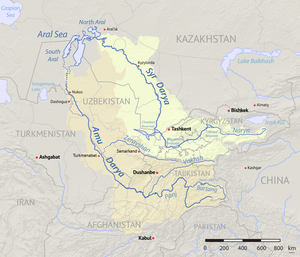
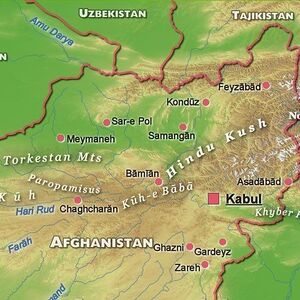
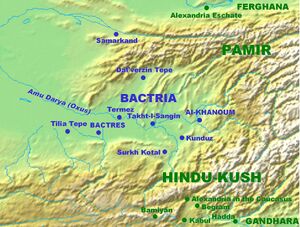
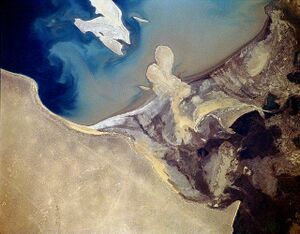
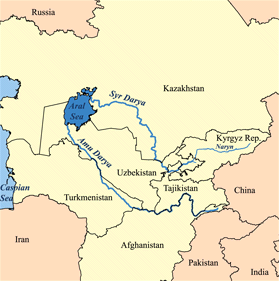
Oxus River (आक्सस नदी) is the longest river in Southwest Asia. This region of central Asia is considered by some scholars to be the original home of Jat people.
Variants of name
- Ōxus (Anabasis by Arrian, p. 199, 200, 202, 234, 235, 247, 274, 358, 387, 401.)
- Amu(आमू) (AS, p.66)
- Oxus (आक्सस) दे. Vankshu (वंक्षु), Vakshu (वक्षु), Chakshu (चक्षु) (AS, p.60)
- Vakshu/Vaksu (वक्षु) दे. Vankshu (वंक्षु) (AS, p.828)
- Vankshu River (वंक्षु नदी) (AS, p.826)
- Chakshu चक्षु (AS, p.325)
- Amu Darya
- Chakshu (चक्षु) (Panini in Ashtadhyayi)
- Chakshu (चक्सु) Mahabharata (XIV.14.25)
- Gihon/Gihun/Dgihun
- Jayhun/ Jayhoun
- Oxus (Greek)
Origin of the name
Amu is said to have come from the city of Āmul, now known as Türkmenabat. It is formed by the junction of the Vakhsh River and Panj River rivers. Many local people refer to the river as Jayhoun (جيحون) which was thought to be a derivative of Gihon, the biblical name for one of the four rivers of the Garden of Eden or paradise. [1] The river is also known by this name to most of the medieval Islamic writers.
Hydrology
The river is navigable for over 1450 km (800 miles). Its total length is 2400 km (1500 miles) and its drainage basin totals 534.739 km² in area, providing a mean discharge of around 55 cubic kilometres of water per year, all of the water comes from the high mountains in the south where annual precipitation can be over 1000 millimetres. Even before large-scale irrigation began, high summer evaporation meant that not all of this discharge reached the Aral Sea - though there is some evidence the large Pamir glaciers provided enough meltwater for the Aral to overflow during the thirteenth and fourteenth centuries A.D.
Mention by Panini
Chakshu (चक्षु) is mentioned by Panini in Ashtadhyayi. [2]
Mention by Pliny
Pliny[3] mentions 'Nations situated around the Hyrcanian Sea.'....the Derbices also,18 through the middle of whose territory the river Oxus19 runs, after rising in Lake Oxus,20....
18 This was a tribe, apparently of Scythian origin, settled in Margiana, on the left bank of the Oxus. Strabo says that they worshipped the earth, and forbore to sacrifice or slay any female; but that they put to death their fellow-creatures as soon as they had passed their seventieth year, it being the privilege of the next of kin to eat the flesh of the deceased person. The aged women, however, they used to strangle, and then consign them to the earth.
19 The modern Jihoun or Amou. It now flows into the Sea of Aral, but the ancients universally speak of it as running into the Caspian; and there are still existing distinct traces of a channel extending in a southwesterly direction from the sea of Aral to the Caspian, by which at least a portion, and probably the whole of the waters of the Oxus found their way. into the Caspian; and not improbably the Sea of Aral itself was connected with the Caspian by this channel.
20 Most probably under this name he means the Sea of Aral.
History
V. S. Agrawala[4] writes that Patanjali mentions names of two other janapadas, viz., Rishika and Jihnu. Rishika - The Rishika occurs in Mahabharata as part of Sakadvipa, Arjuna conquered Rishikas across the Vakshu (Oxus), which flowed through the Saka country. Rishikas were later known as Yuechis, whose language was called Ārśi. Jihnu is perhaps modern Jhind.
Jat History
Bhim Singh Dahiya [5] writtes about the Solgi/ Solanki/ Sulika / Chulika clan. According to him they are mentioned in the Puranas as Sulikas and Chulikas. The Matsya Purana says that they were the people through whose country flowed the river Chaksu. [6] Pargitar suggests that Chakshu may perhaps be taken for Vaksu which is the Oxus, and says that in that case the Sulikas may be the people on the Oxus river in Turkistan. [7] The Brihat Samhita connects these people with the Gandhars and Vokkanas, (occupying modern Wakhan). According to a Buddhist historian of Tibet, Tara Nath, The Kingdom of Sulik was located beyond Togara which may be further identified with the country of the Tokharas, [8] according to some Togara may be identified with modern Ter in the south, which does not seem to be correct. P.C. Bagchi in, “India and Central Asia” says that the Sulikas are originally from Sogdiana In Central Asia, and came to settle in India. [9] According to him the Sulki Rajputs of Shahpur District, the Solgi and Solakhi Jats of Multan region and the Sud of Amritsar Ludhiana in the Punjab, the Chalukyas of the Deccan, and the Solankis of Gujarat in ancient times, appear to be the remnants of the Sogdians. According to Buddha Prakash, the word Chulika is Variant of Sulika, which represents the Chinese Suli. [10] The Markandeya Purana Mentions them as two different people, both in the north. [11]
Hukum Singh Panwar (Pauria)[12] writes... What is the ethnic stock of these Rigvedic republican tribes? Is there any ethnic affinity between the Paninian and the Rigvedic republican tribes? Answers to these questions will go a long way in determining the ethnological connexions and antiquity of the forefathers of the Jats, who are already identified as the descendents of the republican tribes described by Panini. There are conflicting views regarding the ethnic affinity of some tribes who fought against the Bharatas in the Dasarajna war. Mr. Ram Chandra Jain holds that they were pre-Aryan non-Aryan Bharatiya jana or people organised as republics during the troublous times of national peril212. But in view of the overwhelming evidence, Jain's assertion is unacceptable,
The Yadus, Turbasus, Druhyus, Anus and Purus were positively Aryans of the Lunar stock213. The Ajas, Sigrus, and Yakshus, the eastern tribes, are generally regarded as non-Aryan, though there is no definite information on this point214. Giving them the benefit of doubt, they too, might be regarded as some Aryan tribes, for we come across Aja and Ajas as an Aryan king and people in Ayodhya and Aja-Midha as a king and family in the Pururav stock215. It is very interesting to note that there are Aja, Ajarya, Ajurya, Aja-Midha and Midha or Mirdha sanskritised as Gurjar) tribes among the Jats. Similarly, we find or Sigru or Sigroha and Jakhar among them. The last tribe, (viz. the Jakhar) claim Jakha or Jakhu (Yaksha or Yakshu) to be their most ancient eponymous progenitor216. After their defeat on the Yamuna
212. Jain, RC; op. cit., p. 28.
213. The R.V., Brahmanas, Mbt, CV. Vaidya, Pargiter, Pusalker, RK., Mllkerji and a host of native and alien scholars support it.
214. Pusalker, A.D.; Aryan Settlements in Ind., in the Vedic Age, Bhartiya Vidya Bhavan, Bombay, 1965, p. 251.
215. Pargiter. F.E.; AIHT, Delhi, 1972, pp. 92, 121,126,136,147,132; 99-101, 110-13, 115-17. 122-3.225-27.
216. Yoginder Pal Shastri, op.cit., p. 468. Amichandra Sharma,Jat Varna Mimamsa, V.S. 1967. p. 2 . The Jats of Jakhar tribe traditionally remember Jakha or Jakhu as their progenitor.
The Jats:Their Origin, Antiquity and Migrations: End of p.150
river they migrated to the Oxus (Greek name) valley and gave name to the valley as Jaksha or Jaaksha217, which was Sanskritised Ikshu or Chakshu, (because I = J = CH, Viz. Jattaur = Chitor)
217. Bhargava.M.L.: Geog. of the Rigvedic India, Lucknow, 1964, p.129; The author opines that Budakhsis and their city Badakshan are known after the combined name of Bheda, the leader of the Yaksus and that of the latter, Bheda is also Jat gotra.
आमू
विजयेन्द्र कुमार माथुर[13] ने लेख किया है ...आमू (AS, p.66) दक्षिण-पश्चिमी एशिया में अफ़ग़ानिस्तान तथा दक्षिणी रूस की सीमा पर बहने वाली नदी है, जिसे प्राचीन भारतीय साहित्य में वंक्षु और विष्णुपुराण में चक्षु कहा गया है। ग्रीक लोग आमू को आक्सस कहते थे।
वंक्षु नदी
विजयेन्द्र कुमार माथुर[14] ने लेख किया है ...वंक्षु (AS, p.826) 'ऑक्सस'(Oxus) या आमू नदी (दक्षिण रूस) का प्राचीन नाम था। इस नदी का उल्लेख महाभारत, सभापर्व 50,20 में हुआ है- प्रमाणरागसंपन्नान् वंक्षुतीरसमुद्भवान्, बल्यर्थ दबतस्तस्मै हिरण्यं रजतं बहु। इस प्रसंग में युधिष्ठिर के राजसूय यज्ञ में वंक्षु नदी प्रदेश के निवासियों द्वारा भेंट में लाए गये तेज़ दौड़ने वाले 'रासभों' ('रासभान् दूरपातिः', महाभारत, सभापर्व 50,19) का भी उल्लेख है। 'रघुवंश' 4, 67 में 'सिंधुतीर विचेष्टनैः' ('विनीताध्व श्रमास्तस्य सिंधुतीरविचेश्टनैः, दुधुर्वुजिन: स्कन्धाँल्लग्नकुंकुमकेसरान्) के स्थान में किसी-किसी प्राचीन प्रति में 'वंक्षुतीर विचेष्टनै:, पाठ है। यदि यह शुद्ध है तो कालिदास के समय में वंक्षु नदी के प्रदेश को भारत के सम्राट अपने साम्राज्य का ही एक अंग समझते थे, इस तथ्य को मान्यता प्रदान करनी पड़ेगी। वंक्षु का रूपांतर साहित्य में 'वक्षु' या चक्षु भी मिलता है। (दे. चक्षु) अरबी भाषा में इस नदी को जिहून कहते हैं।
In Greek literature
In classical antiquity, the river was known as the Oxus in the Greek language, a clear derivative of Vakhsh—the name of the largest tributary of the Amu. It was known as Jayhun or Gihun in ancient Arabic sources. Jayhun was likely influenced by Dgihun, the traditional name given to it by the people who inhabited its surrounding region.[15]
Source of the River
One source of the Amu Darya is the Pamir River, which emerges from Lake Zorkul/Victoria in the Pamir Mountains (ancient Mount Imeon), flowing east to Ishtragh, where it turns north and then east north-west through the Hindu Kush as the Panj River, forming the border of Afghanistan and Tajikistan where it passes the Tajik-Afghan Friendship Bridge, and subsequently the border of Afghanistan and Uzbekistan for about 200 km, passing Termez and the Afghanistan-Uzbekistan Friendship Bridge. It follows the border of Afghanistan and Turkmenistan for another 100 km before it flows into Turkmenistan at Kerki. As Amudarya, it flows across Turkmenistan south to north, passing Turkmenabat, and forms the border of Turkmenistan and Uzbekistan from Khalkabad. It is then split into many waterways that used to form the river delta joining the Aral Sea, passing Urgench, Dashoguz and other cities, but it does not reach what is left of the sea anymore and is lost in the desert.
Another claimed source of the Amu Darya is an ice cave at the end of the Waghjir Valley, located in the Wakhan Corridor, in the Pamir Mountains, on the border with Pakistan. A glacier turns into the Wakhan river and joins the Pamir River about 50 km downstream.
Use of water from the Amu Darya for irrigation has been a major contributing factor in the shrinking of the Aral Sea since the late 1950s.
Historical records state that in different periods the river flowed into the Aral Sea (from the south), the Caspian Sea (from the east) or both, similar to the Syr Darya (Jaxartes, in Ancient Greek).
In Puranas
In Vayu Purana and Matsya Purana, the Oxus is mentioned as the river Chakshu, flowing through the countries of Tusharas (Takhar Jat clan) (Rishikas?), Lampakas (Lamba Jat clan, Pahlavas (Pahlawat, Paradas (Parauda Jat clan) and Shakas etc.
The Vayu Purana (47, 44) and the Matsya Purana, (121, 45) mention that:
- सान्ध्रान् स्तुखारान् लम्पकान् पह्लवान् दरदान् छकान्
- अताञ्जनापदाञ्चक्षु प्लावयन्ती गतोदधिम्
The Chaksu or Oxus river goes to the sea after irrigating the lands of the Sandhrans (Jats) , Tukharas (Takhar Jats), Lampakas (Lamba Jats), Pahlavas (Pehlavi-Iranians) Daradas (of Kashmir) and Chhakans (Chhikara Jats).
Chinese pilgrim Hiuen Tsang who visited Kapisa in 644 AD calls it Kai-pi-shi(h). Hiuen Tsang describes Kai-pi-shi[16] as a flourishing kingdom ruled by a Buddhist Kshatriya king holding sway over ten neighboring states including Lampaka, Nagarahara, Gandhara and Banu etc.
In Mahabharata
Chaksu (चक्सु) is mentioned in Mahabharata (XIV.14.25), (XIV.14),
Vankshu River (वंक्षु) is mentioned in Mahabharata (II.47.22)
Sabha Parva, Mahabharata/Book II Chapter 47 mentions the Kings who brought tributes to Yudhishthira: Vankshu River (वंक्षु) is mentioned in Mahabharata (II.47.22). [17].....And the Valhikas also presented numerous blankets of woollen texture manufactured in China (? On the banks of Vankshu) and numerous skins of the Ranku deer, and clothes manufactured from jute, and others woven with the threads spun by insects.
Aswamedha Parva, Mahabharata/Book 14 Chapter 8 mentions thousand names of Shiva. Chakshu is one of them.
External links
Further reading
- George Nathaniel Curzon, 1st Marquess Curzon of Kedleston. 1896. The Pamirs and the Source of the Oxus. Royal Geographical Society, London. Reprint: Elibron Classics Series, Adamant Media Corporation. 2005. ISBN 1-4021-5983-8 (pbk; ISBN 1-4021-3090-2 (hbk).
- Gordon, T. E. 1876. The Roof of the World: Being the Narrative of a Journey over the high plateau of Tibet to the Russian Frontier and the Oxus sources on Pamir. Edinburgh. Edmonston and Douglas. Reprint by Ch'eng Wen Publishing Company. Taipei. 1971.
- Arnold J. Toynbee. 1961. Between Oxus and Jumna. London. Oxford University Press.
- John Wood, 1872. A Journey to the Source of the River Oxus. With an essay on the Geography of the Valley of the Oxus by Colonel Henry Yule. London: John Murray.
References
- ↑ William C. Brice. 1981. Historical Atlas of Islam (Hardcover). Leiden with support and patronage from Encyclopaedia of Islam. ISBN 90-04-06116-9.
- ↑ V. S. Agrawala: India as Known to Panini, 1953, p.68
- ↑ Natural History by Pliny Book VI/Chapter 18
- ↑ V. S. Agrawala: India as Known to Panini, 1953, p.62
- ↑ Bhim Singh Dahiya, Jats the Ancient Rulers, p. 270-271
- ↑ Chapter XX 45-46
- ↑ Markandeya Purana, p, 342 note
- ↑ 159-See also Indian Antiquary , IV, 364
- ↑ 160-op.cit.p.146
- ↑ Studies in Indian History and Civilization bu Buddha Prakash, p. 258
- ↑ Quoted by. B.C. Law, op, cit.,p.384
- ↑ The Jats:Their Origin, Antiquity and Migrations/An Historico-Somatometrical study bearing on the origin of the Jats,p.150-151
- ↑ Aitihasik Sthanavali by Vijayendra Kumar Mathur, p.66
- ↑ Aitihasik Sthanavali by Vijayendra Kumar Mathur, p.826
- ↑ Encyclopædia Britannica Online: Amu Darya
- ↑ Su-kao-seng-chaun, Chapter 2, (no. 1493); Kai-yuan-lu, chapter 7; Publications, 1904, p 122-123, published by Oriental Translation Fund (Editors Dr T. W. Rhys Davis, S. W. Bushel, London, Royal Asiatic Society).
- ↑ प्रमाण रागस्पर्शाढ्यं बाह्ली चीन (? वंक्षुतीर) समुद्भवम, और्णं च राङ्कवं चैव कीटजं पट्टजं तदा

